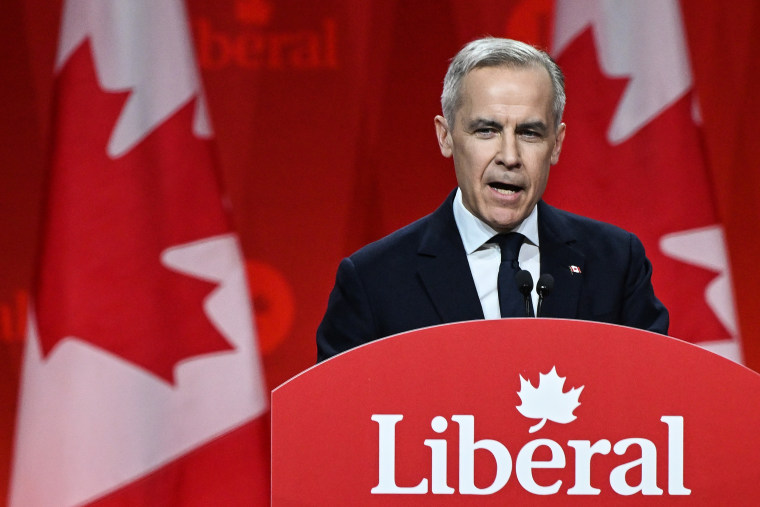BREAKING NEWS
Farmers face steep losses in the middle of Trump’s trade war and funding cuts

Jennifer Gilkerson never imagined that her West Virginia farm’s freeze-dried fruits would get caught up in political fights in Washington, D.C.
But last Friday, she learned that funding for a U.S. Agriculture Department program that helps schools and food banks buy products from local farmers like her had been cut. Without those federal dollars, Gilkerson no longer expects local schools to be able to buy her freeze-dried fruits, which she has already spent thousands of dollars preparing to produce.
“We’re just in such a state of shock. We just don’t really even know how to respond to all this. We thought that this was sacred and really untouchable,” Gilkerson said. “Everyone thinks all farmers voted for this, but we did not vote for this.”
From funding cuts to tariffs, farmers have found themselves caught in the middle of President Donald Trump’s escalation of trade wars and efforts to slash billions of dollars in spending, leaving a growing number now struggling to find markets for their products and facing the risk of steep losses for the year ahead.
Trump has acknowledged the impact his trade policies will have on farmers, telling them in his address to Congress this month that there will be “a little bit of an adjustment period” and that farmers will have to “bear with me again.” When it comes to spending cuts at the Agriculture Department and other agencies, Treasury Secretary Scott Bessent said in a CNBC interview this week, the current federal spending levels are unsustainable and there will have to be a “detox period” for the economy as cuts are made.
But farmers across the country — from small organic berry growers in Maine to large-scale hog producers in Iowa — say those policy changes could cripple their businesses if they aren’t resolved soon, wreaking long-lasting damage on the U.S. agriculture industry.
“I think any farmer will tell you that we will take some short-term pain, but do not make this a long-term extended trade war, because that just won’t be good for agriculture or for the country in general,” said Bob Hemesath, an Iowa farmer who grows corn and raises hogs. “I know that this is the way President Trump believes he’s going to create better markets long term. I hope he’s correct. But my fear is that once you lose those markets to other suppliers, it’s very hard to get them back.”
U.S. farmers depend on exporting their products because for many products, like corn, the country produces more than it is able to consume. Foreign buyers are also more willing to buy agricultural products people in the United States don’t want, like chicken feet or cow tongues.
But those overseas markets are now in question as Trump threatens to ratchet up the amount of tariffs charged on products being shipped into the United States — a move that is already causing other countries to retaliate with their own tariffs on U.S. goods.
“I’ve been at this for 45 years, and for all of those years, any time there is a trade dispute with another country, they recognize that our soft underbelly, where we really get sensitive, is when you start messing with our food exports,” said Chuck Conner, head of the National Council of Farmer Cooperatives. “That has always been the case, and that is the case this time around on steroids.”
Farmers say they are already seeing the effects after Trump put an additional 20% tariff on Chinese imports, after which China responded with an additional 10% to 15% tariff on U.S. agriculture products, including pork, wheat and corn.
After Trump briefly placed a 25% tariff on all imports from Canada last month, cattle farmers in Maine got notices that their grain prices would be increasing 15%, said Sarah Alexander, executive director of the Maine Organic Farmers and Gardeners Association. Trump later walked back some of the tariffs, but he also warned that more are to come. A farmer also told Alexander that his price quote for a greenhouse shot up this week after Trump put a 25% tariff on all steel and aluminum imports.
“Consumers are going to see these impacts if farms are not able to carry through with their plans or their costs increase dramatically, whether it’s in what products are actually available this year or that the cost is going to have to go up because farmers can’t shoulder all of those changes themselves,” Alexander said.
Tariffs hit amid issues with federal aid
Federal funding cuts and freezes, along with staffing shortages at the Agriculture Department, have also been rippling across the U.S. agriculture industry. Farmers say they rely on grants and loans from the Agriculture Department to help make their products more affordable for U.S. consumers and weather the natural volatility in the market for agriculture commodities.
As Gilkerson tries to figure out a new market for her farm’s freeze-dried fruits, another group of West Virginia farmers has also been caught up in funding cuts to a separate Agriculture Department program to help promote local foods.
A group of farmers had been working to launch a brand of West Virginia-grown products called Appalachian Cellar. After months of work, they were preparing to begin distributing the brand to grocery stores and other food distributors when the Agriculture Department told them their funding had been cut off as of Jan. 19, the day before Trump entered office.
“I’ve got 31 farmers who are pissed off,” said Spencer Moss, executive director of the West Virginia Food and Farm Coalition, who was working on launching the line of products. “We are rounding the corner into the planting season, and we are supposed to be ramping up, but we are not. We are unable to ramp up.”
Not only will the group not be getting funding going forward for expenses it had coming up, but it’s unclear whether it will get reimbursed, as planned, for $100,000 in expenses related to the grant it had already paid for, Moss said.
“This is the economy of rural America. West Virginia is a wholly rural state, and so developing this agriculture economy in the state is extremely important,” she said. “These farmers pay their property taxes, they’re business owners, a lot of times they’re commissioners or school board members. These are the drivers that keep rural communities alive. So it feels like a divestment in rural communities across the board.”
Seth Kroeck, a blueberry farmer in Maine, said he received a $50,000 grant to spread 200,000 cubic yards of mulch on his wild blueberries to help improve his crop yields. He has the truck, the fuel and the manpower lined up to spread the mulch and has to get started in the coming weeks as the planting season gets underway.
But he’s unsure whether he will actually get reimbursed by the Agriculture Department, because he knows of several other farmers still waiting to get paid for equipment they purchased under Agriculture Department grants.
“It has really sent a chill among a lot of farmers,” Kroeck said. “You sign a contract with the USDA, you expect that they’re going to pay on it. You would never expect that they’re not going to fulfill their end of the deal. It makes me worry in a broader sense about where we’re heading. So much of what we do with each other is based on that basic trust, and to have that be shattered is very, very worrisome.”
There’s uncertainty as farmers are trying to make decisions at the start of the planting season in many parts of the country.
In Virginia, John Boyd is unsure whether his loan from the Agriculture Department will come through in time for him to buy the seeds he needs to begin planting his soybean crops for this year. Boyd typically gets an Agriculture Department loan in the spring to help cover some of the cost of planting until he can harvest the crops in the fall and use the proceeds to repay the loan.
But so far, the loan money hasn’t come through, and he has been unable to get any update from the Agriculture Department about whether or when it will be available. With just days until he needs to start putting his seeds in the ground, Boyd said, he’s urgently trying to negotiate a payment plan with his seed supplier or find another way to finance the expense.
“It’s planting season, and there’s a cloud of uncertainty among the agriculture industry with this president,” said Boyd, who is president of the National Black Farmers Association. “I’ve got real debt; I’ve got real expenses. But I also have the will to farm in some sort of way. I can’t tell you how, but I am making calls and trying to put some things in place to get through this crisis the president has put us in.”
Soybean prices, which have already been falling amid a glut of supply in the market as production has ramped up globally, have been tumbling in recent years, and he worries they will fall further in a trade war with China.
“What’s alarming here to me as a leader in the farm community and civil rights work is that it’s the farmer that is the first getting affected, and it was the farmer that delivered for this president,” Boyd said. “They were all in for Trump, and they are the first in line to be affected.”
Prices for soybeans, like other agricultural products, including corn, wheat and pork, are set not by the individual farmers but by a wider commodities market, which factors in the global supply and demand. If demand for U.S. agriculture products from a major buyer, like China, goes down as a result of tariffs, so can the price.
“In order to get a fair price, you need a good, steady market, and the president is disrupting the market,” Boyd said.
Farmers have been through Trump’s trade wars before in 2018 and 2019, when he imposed tariffs on China, which retaliated with its own tariffs on U.S. farm products, sending sales tumbling. In response, Trump set up a payment program during his first term to compensate some of the affected farmers. The amount of payments doled out was about equivalent to the revenue the United States collected from the tariffs on Chinese imports.
Trump hasn’t said whether he will implement a similar payment plan again. Commerce Secretary Howard Lutnick said Trump’s moves are intended to improve the longer-term picture for farmers by ultimately creating a more level playing field overseas.
“He understands that the best way to get our farmers, our ranchers and our fishermen’s produce and products in the rest of the world — which they block, India blocks our farmers, all these countries block our farmers — the way to grow it is to make deals with them where they have to understand the power of the U.S. economy,” Lutnick said in a Bloomberg TV interview Thursday.
In the meantime, farmers are trying to figure out how to pay for their current bills and how to cut costs to lessen their losses.
In Iowa, Hemesath, who is on the board of the National Corn Growers Association and president of Farmers for Free Trade, said he’s bracing for the possibility of losing money on his crops this year if there is no change in policy in the coming months.
“We’re used to the ups and downs in the markets. There’s no doubt about that, but we need to be looking for more markets and building on the markets that we already have,” he said. “So long term, we definitely have to get this resolved to stay viable.”
BREAKING NEWS
How Trump united Canada against him and flipped its election upside down

The hostility extends to homegrown Trump supporters such as Canadian hockey legend Wayne Gretzky, who was at Trump’s Mar-a-Lago resort on election night and attended his inauguration. This week, viral photos from a Toronto liquor store showed labels under Gretzky’s wine range altered to include descriptions such as “weak & backstabbery.”
Former Prime Minister Jean Chrétien said Trump had “united us as never before.”
“I think I will propose him for the Order of Canada,” the country’s highest civilian honor, Chrétien joked as the governing Liberal Party met in Ottawa last weekend to elect a successor to Canada’s leader of almost a decade, the highly unpopular Justin Trudeau.
Experts say the man they overwhelmingly chose, Mark Carney, may be uniquely positioned to push back against Trump’s aggression, with a background in finance and crisis management that includes running the Bank of Canada after the 2008 global financial crisis and the Bank of England during the Brexit process.
Like Trump, Carney, who took office as prime minister on Friday, spent much of his life in the private sector and had never held elected office before becoming his country’s leader.
“He’s been sort of the global elite all his life,” Malloy said. “Normally, that’s not really the route for success for a rookie politician. But these are unusual times.”
‘Resurrected from the dead’
Only a few months ago, the Liberals under Trudeau were looking like “absolute toast” in the next Canadian election, which is required to take place by October of this year, Malloy said.
With his approval rating already at an all-time low, Trudeau’s problems were only compounded by Trump’s tariff threats, which began shortly after he was elected in November.
Internal disagreement over how to respond to those threats created turmoil among the Liberals, with Finance Minister Chrystia Freeland’s scathing resignation letter in December ultimately forcing Trudeau to announce he would step down.

It seemed almost certain the Liberals would be thrashed in the next election by the Conservative Party, led by Pierre Poilievre.
Poilievre, whose style has been described as “Trump light,” had embraced the populist wing of his party, expressing support for truckers who paralyzed Ottawa with anti-vaccine protests in 2022. Among his supporters was Elon Musk.
Then Trump happened.
On his first day in office, Trump announced a 25% tariff on imports from Canada and Mexico, two of the biggest U.S. trading partners. Those tariffs were paused for a month before going into effect on March 4. Markets immediately began convulsing, and in the days that followed, Trump exempted more than a third of goods coming from Canada until April 2.
Trump said he was imposing the tariffs on Canada and Mexico because of their role in the U.S. fentanyl crisis and illegal immigration, mystifying Canadians who point to the U.S. government’s own data showing that Canada is responsible for less than 1% of the fentanyl and undocumented migrants coming across the northern and southern U.S. borders.
Canada is also subject to the 25% U.S. tariff on steel and aluminum imports that took effect globally on Wednesday.
Ottawa responded to those tariffs with its own levies on some $21 billion worth of U.S. goods, and it has also requested a dispute consultation at the World Trade Organization.
Alongside the tariffs, Trump has repeatedly referred to Trudeau as the “governor” of Canada, which with 40 million people has about the same population as California.
Trump’s derision continued on Thursday even as his secretary of state, Marco Rubio, made his first official trip to Canada for a meeting of top diplomats from the Group of Seven industrialized democracies.
“To be honest with you, Canada only works as a state,” Trump said from the Oval Office.
Asked about the issue on Friday, Rubio said it had not come up at the G7 meeting but that there was a “disagreement” between Trump’s position and the position of the Canadian government.
Canadian Foreign Minister Mélanie Joly said she told Rubio that “Canada’s sovereignty is not up to debate.”
“You’re in our country, you respect our people. Period,” she said at a news conference after the meeting in La Malbaie, Quebec.
Fueled by anger at Trump, Canadians have expressed growing support for the Liberals in the upcoming election, almost entirely closing the gap with the Conservatives in a matter of weeks. The Conservatives, who had a lead of almost 20 points a month ago, are now ahead by only 1 percentage point, the Canadian polling firm Nanos said this week.
“The Liberals have basically been resurrected from the dead” because of the crisis Trump created, Malloy said.
As Carney took office on Friday, he rejected Trump’s statehood proposal, saying “America is not Canada.”
“We will never, ever, in any way, shape or form, be part of the United States,” Carney, who turns 60 on Sunday, said after being sworn in.

Though Carney is a novice politician, that could work in his favor, said Maite Gonzalez Latorre, a program assistant at the Atlantic Council in Washington who is from Edmonton, Alberta.
“Mark Carney has experience in the U.K., he has experience in Canada, but he also has private sector experience,” Gonzalez Latorre said, “which I think will give him an advantage, especially when it comes to tariffs and and speaking with Trump directly.”
Carney’s top concerns for the moment, she said, are how to deal with Trump and how the U.S. tariffs are going to affect Canadians. His next moves and Trump’s response to them will influence when Carney calls the election, which could still end in victory for the Conservatives.
As with so many of Trump’s policies and actions, Malloy said, it remains unclear what exactly he is trying to achieve with his antagonism toward Canada.
His actions may have sidelined a potential ally in Poilievre, “who would have been a relatively supportive leader,” Malloy said. And though he took down Trudeau, Trump also revived the fortunes of Trudeau’s party, which is staunchly opposed to his policies.
“What is Mr. Trump’s endgame other than chaos? And what’s the point?” Malloy said. “Because so far, he’s only doing things that hurt his interests and the interests of the United States.”
BREAKING NEWS
Vance discusses Elon Musk and the economy in NBC News interview

WASHINGTON — Vice President JD Vance acknowledged Friday that Elon Musk has made “mistakes” while executing mass firings of federal employees and emphasized that he believes there are “a lot of good people who work in the government.”
“Elon himself has said that sometimes you do something, you make a mistake, and then you undo the mistake. I’m accepting of mistakes,” Vance said in an interview with NBC News.
“I also think you have to quickly correct those mistakes. But I’m also very aware of the fact that there are a lot of good people who work in the government — a lot of people who are doing a very good job. And we want to try to preserve as much of what works in government as possible, while eliminating what doesn’t work.”
Vance’s gentler tone represented a contrast from the chainsaw approach that Musk, the world’s wealthiest man, has taken as he leads President Donald Trump’s initiative to slash federal spending and reorient the federal bureaucracy. The firings of thousands of government employees has been the centerpiece of Musk’s work over the first seven weeks of Trump’s second White House administration, with the cuts yielding lawsuits and pushback from judges. Musk has broadly characterized federal workers as “fraudsters” who can’t be trusted to do their jobs.
“I think some people clearly are collecting a check and not doing a job,” Vance said when asked about such comments from Musk. “Now, how many people is that? I don’t know, in a 3 million-strong federal workforce, whether it’s a few thousand or much larger than that.”
“However big the problem is, it is a problem when people are living off the generosity of the American taxpayer in a civil service job and not doing the people’s business,” he added. “That doesn’t distract or detract from the fact that you do have a lot of great civil servants who are doing important work. But I think most of those great civil servants would say we want to be empowered to do our job. We don’t want the person who doesn’t show up five days a week to make it harder for us to do what we need to do.”
Vance’s comments came during an exclusive and wide-ranging interview aboard Air Force Two, as the vice president and second lady Usha Vance returned from a visit to a plastics factory in Bay City, Michigan. His motorcade’s ride into town illustrated how different life is now for him and his young family.
Dozens of protesters had lined the street leading to the factory, greeting Vance and his traveling party with middle fingers and vulgar signs, one of which featured a crossed-out swastika and read “Go home, scumbag.” The previous night, Vance was booed while arriving for a performance at the Kennedy Center in Washington. And while walking with his 3-year-old daughter near their home in Ohio last weekend, Vance found himself in a civil but, in his description, upsetting conversation with pro-Ukraine demonstrators.
“The thing at the Kennedy Center I thought was funny,” Vance said aboard his plane Friday afternoon. “The thing by my house I thought was kind of annoying. I think you just kind of take the good with the bad. … I kind of just see it as, depending on your perspective, a feature or a bug of this new life.”
In his remarks at the factory, where he was welcomed by a friendlier, pro-Trump audience filled with local Republicans, Vance touted the administration’s commitment to manufacturing and economic recovery while tempering expectations for the rapid turnaround that Trump promised on the campaign trail.
A majority of respondents in two polls released this week — 56% of adults surveyed by CNN, 54% of registered voters surveyed by Quinnipiac University — said they disapproved of how Trump is handling the economy. Meanwhile, Trump’s push for tariffs on foreign products has ignited fears of a trade war that could raise consumer prices.
“Now I have to be honest with you,” Vance said in Bay City. “The road ahead of us is long, but we are already, in just seven short weeks, starting to see early indications of the president’s vision becoming our shared American reality.”
During the campaign, Vance frequently spoke of a woman he had met who said that she and her husband could no longer afford their weekly tradition of grilling steaks on Friday nights. Reminded of that story aboard his plane Friday, Vance described recent lower gas prices as a positive sign.
Vance also acknowledged that “you already see things leveling off to, not an ideal situation, but a much better and more significant improvement” while casting blame on former President Joe Biden, whose policies he said had left Trump in a hole.
“My ambition is that we see some pretty quick results, that you start to see at least a pathway towards financial stability,” said Vance, specifically noting 10,000 manufacturing jobs added last month. “You’re going to see progress. I think it’s going to be incremental progress. But I also think it’s important to be honest with people that you don’t get to $2 trillion deficits overnight. You’re not going to get out of $2 trillion deficits overnight.”
Vance also discussed his early role in shaping and articulating Trump’s foreign policy agenda, from a provocative speech at last month’s Munich Security Conference to an extraordinary Oval Office clash two weeks ago with Ukrainian President Volodymyr Zelenskyy, whom Vance had accused of being insufficiently thankful for U.S. aid.
“I just try not to be overly scripted,” Vance said before recalling his speech in Munich, which upbraided European leaders over issues such as free speech and mass migration. “The classic thing to do in Munich would have been to show up and give a speech about NATO or give a speech about where the Ukraine-Russia thing was at that moment in time, and just sort of thought to myself, like, ‘What is it that I think is really important to say?’ And the president was OK with me saying it, so I said it.”
Vance added that he doesn’t “go into these things trying to be like a spokesman for the administration. Some of that happens naturally, but fundamentally, the president is the spokesman for the administration, and everything flows from there. I try to do a good job. I try to say things both that I think are true but also are in accordance with the president’s preferences. And let the chips fall where they may.”
Trump, who is constitutionally barred from serving another term, raised eyebrows in a Fox News interview last month by saying it was “too early” to anoint Vance as his successor in 2028. Vance and others close to Trump have since brushed off the question and Trump’s answer to it, agreeing that such talk was premature.
Asked a variation of the question Friday — does he view himself as Trump’s successor? — Vance replied that he’s not thinking about a presidential campaign at the moment. He related the story of how he felt on Election Night, when, surrounded by his closest friends and family, it became clear he had won the vice presidency.
“Wow, I’m the vice president-elect of the United States,” Vance recalled thinking. “And, you know, if I never go further in politics, I’m totally fine with that, but we get a really good opportunity to do a lot of really good s— the next four years.”
“If I do really well for the next four years, everything else will take care of itself. … Now, like, yeah, in two and a half years, will that become harder? Will people be more focused on politics than on what the White House is maybe doing that particular day? Maybe,” he added.
“I mean, man, if I was like a central figure to getting the Russia-Ukraine crisis solved, who gives a s— what I do after this?” Vance said. “That’s kind of the attitude I take. So I’m very focused on doing a good job.”
BREAKING NEWS
Senate votes on government funding bill today; Trump delivers remarks at DOJ

Democratic campaign committees and state parties are partnering to host a series of town halls in Republican-held districts after congressional Republicans were advised against holding more town hall-style events in person following tense interactions that went viral.
The list of districts where Democrats plan to hold events includes several that are held by GOP lawmakers who are expected to have close House races next year: Rep. Juan Ciscomani in Arizona’s 6th District, Rep. Gabe Evans in Colorado’s 8th District, Rep. Zach Nunn in Iowa’s 3rd District, Rep. John James in Michigan’s 10th District, Rep. Don Bacon in Nebraska’s 2nd District, and Reps. Ryan Mackenzie and Rob Bresnahan in Pennsylvania’s 7th and 8th districts, respectively.
Democratic National Committee Chair Ken Martin said in a statement that Republican lawmakers are “terrified to be in the same room as the people who sent them to Washington.”
“If they won’t talk to their own voters, then Democrats will. That’s why we’ll be hosting People’s Town Halls in all 50 states across the country, starting now with vulnerable GOP-held target districts. Working families deserve to have their voices heard, even if Republicans want to ignore them,” Martin added.
Democratic Congressional Campaign Committee Chair Susan DelBene, D-Wash., said in a statement that congressional Republicans “are failing to do the most basic aspect of their jobs: meeting with the people they represent.”
The move from Democrats, who have been on their heels since the start of the Trump administration, comes after several GOP lawmakers were confronted at town halls in their districts.
In one instance, videos showed attendees booing Sen. Roger Marshall, R-Kan., after he defended Elon Musk’s Department of Government Efficiency. In another instance, Rep. Keith Self, R-Texas, was confronted with chants of “Vote you out,” at one of his town halls.
Republicans have accused Democrats of organizing protesters to attend Republican-led town halls and disrupting them.
-

 Africa4 days ago
Africa4 days agoSurvivor of Liverpool car ramming talks of shock and panic
-

 Sports4 days ago
Sports4 days agoThe Knicks are bringing hope and title dreams back to New York after years in the doldrums
-

 Lifestyle4 days ago
Lifestyle4 days agoFaizan Zaki hopes to go from spelling bee runner-up to champ
-

 Lifestyle4 days ago
Lifestyle4 days agoChildren and careers: Talking to kids about what they want to be when they grow up
-

 Lifestyle4 days ago
Lifestyle4 days agoHow to decorate a patio, balcony or other small outdoor space
-

 Middle East4 days ago
Middle East4 days agoGaza’s aid system isn’t broken. It’s working exactly as designed | Humanitarian Crises
-

 Middle East5 days ago
Middle East5 days agoHajj pilgrimage in Saudi Arabia to begin on June 4 | Religion News
-

 Lifestyle4 days ago
Lifestyle4 days agoA guide to navigating tariffs if you’re planning a wedding




